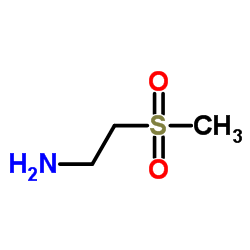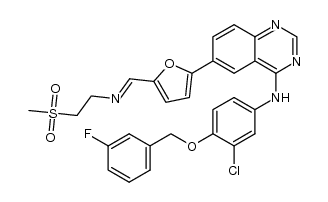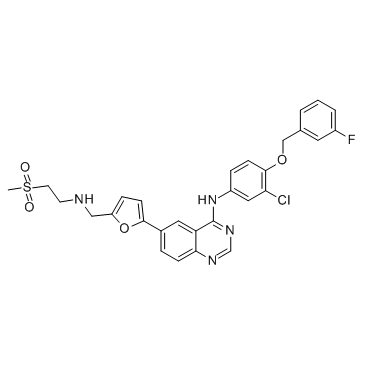388082-78-8
| Name | Lapatinib ditosylate |
|---|---|
| Synonyms |
N-{3-Chloro-4-[(3-fluorobenzyl)oxy]phenyl}-6-[5-({[2-(methylsulfonyl)ethyl]amino}methyl)-2-furyl]quinazolin-4-amine bis(4-methylbenzenesulfonate) hydrate
N-{3-Chloro-4-[(3-fluorobenzyl)oxy]phenyl}-6-[5-({[2-(methylsulfonyl)ethyl]amino}methyl)-2-furyl]-4-quinazolinamine 4-methylbenzenesulfonate hydrate (1:2:1) Lapatinib ditosylate (USAN) N-[3-Chloro-4-[(3-fluorophenyl)methoxy]phenyl]-6-[5-[[[2-(methylsulfonyl)ethyl]amino]methyl]-2-furanyl]-4-quinazolinamine, 4-methylbenzenesulfonate, hydrate (1:2:1) T66 BN DNJ EMR CG DO1R CF&& H- BT5OJ E1M2SW1 &&2 p-Tosoh H2O Lapatinib Ditosilate 4-Quinazolinamine, N-[3-chloro-4-[(3-fluorophenyl)methoxy]phenyl]-6-[5-[[[2-(methylsulfonyl)ethyl]amino]methyl]-2-furanyl]-, 4-methylbenzenesulfonate, hydrate (1:2:1) Lapatinib ditosylate monohydrate Lapatinib Ditosylate |
| Description | Lapatinib ditosylate monohydrate (GW572016 ditosylate monohydrate) is a potent inhibitor of the ErbB-2 and EGFR tyrosine kinase domains with IC50 values against purified EGFR and ErbB-2 of 10.2 and 9.8 nM, respectively[1]. |
|---|---|
| Related Catalog | |
| Target |
EGFR:10.8 nM (IC50) ErbB2:9.2 nM (IC50) |
| In Vitro | Lapatinib (GW2016; 0.03-10 µM; 6 hours; BT474 and HN5 cells) treatment inhibits receptor autophosphorylation of EGFR and ErbB-2 in a dose-responsive manner. Phosphorylation of serine 473 of AKT was inhibited by GW2016 in a dose-dependent manner[1]. Lapatinib (GW2016; 72 hours; HN5, A-43, BT474, N87, and CaLu-3 cells) treatment has a selective inhibition of the proliferation of human tumor cell lines[1]. Lapatinib (GW2016; 1-10 µM; 72 hours; HN5 cells) treatment results in induces G1 arrest[1]. Western Blot Analysis[1] Cell Line: BT474 and HN5 cells Concentration: 0.03 µM, 0.1 µM, 0.3 µM, 1 µM, 3 µM, or 10 µM Incubation Time: 6 hours Result: Inhibited receptor autophosphorylation of EGFR and ErbB-2 in a dose-responsive manner. Phosphorylation of serine 473 of AKT was also inhibited in a dose-dependent manner. Cell Proliferation Assay[1] Cell Line: HN5, A-43, BT474, N87, and CaLu-3 cells Concentration: Incubation Time: 72 hours Result: Inhibited the growth of tumor cells overexpressing EGFR or ErbB-2. Cell Cycle Analysis[1] Cell Line: HN5 cells Concentration: 1 µM, or 10 µM Incubation Time: 72 hours Result: Resulted in induction of G1 arrest. |
| In Vivo | Lapatinib (GW2016; 30-100 mg/kg; oral administration; twice daily; for 21 days; CD-1 nude female mice) treatment inhibits tumor xenograft growth of the HN5 cells in a dose-responsive manner at 30 and 100 mg/kg, with complete inhibition of tumor growth at the higher dose[1]. Animal Model: CD-1 nude female mice (4-6 weeks old) with HN5 cells[1] Dosage: 30 mg/kg, 100 mg/kg Administration: Oral administration; twice daily; for 21 days Result: Inhibited tumor xenograft growth of the HN5 cells in a dose-responsive manner. |
| References |
| Density | 1.403 g/mL (20.84 °C) |
|---|---|
| Boiling Point | 750.7ºC at 760 mmHg |
| Melting Point | 237 - 239 °C |
| Molecular Formula | C86H86Cl2F2N8O21S6 |
| Molecular Weight | 943.476 |
| Flash Point | 68 °F |
| Exact Mass | 942.184143 |
| PSA | 249.46000 |
| LogP | 12.26450 |
| Index of Refraction | n20/D 1.5520(lit.) |
| Hazard Codes | Xi,N |
|---|---|
| Risk Phrases | R43:May cause sensitization by skin contact. R51/53:Toxic to aquatic organisms, may cause long-term adverse effects in the aquatic environment . |
| Safety Phrases | S24-S37-S61 |
| Precursor 9 | |
|---|---|
| DownStream 1 | |

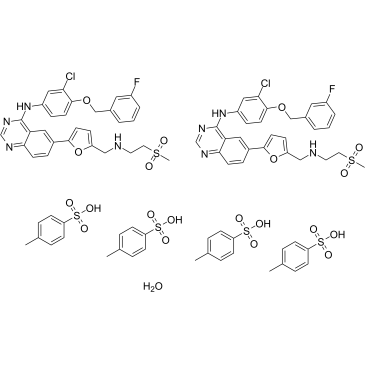

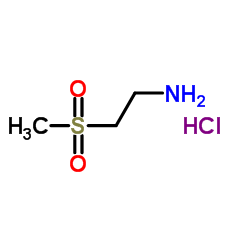
![5-[4-[3-chloro-4-[(3-fluorophenyl)methoxy]anilino]quinazolin-6-yl]furan-2-carbaldehyde structure](https://image.chemsrc.com/caspic/482/231278-84-5.png)
